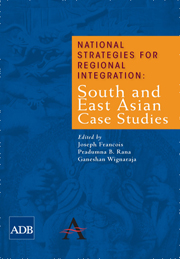Foreword
Published online by Cambridge University Press: 05 March 2012
Summary
Asia, a pivotal region in the world economy, is at an important cross-road in its development path. Having successfully integrated into the global economy over the last five decades through outward-oriented development strategies, the region has embarked on a process of closer regional cooperation and integration. Several factors–the spread of production networks, improvements in infrastructure, falling trade barriers, and technological progress–have spurred the process. One key challenge for an interdependent Asia remains how to strengthen and spread the benefits of the process of regional cooperation and integration. An essential element is effective national strategies for regional cooperation and integration.
The way Asian economies develop and implement effective approaches to regional cooperation and integration is insufficiently understood. Using a set of country cases based on a similar framework, the study examines how each country's integration with its neighbors and more distant regional economies might be improved. Five of these cases are from South Asia (India, Pakistan, Bangladesh, Nepal, and Sri Lanka) and three are from East Asia (the People's Republic of China, Thailand, and Singapore). The country cases illustrate the diversity of Asian development experience and offer lessons for other countries and regions interested in developing national strategies to foster regional integration.
The study indicates four important lessons: (i) integrate with a large neighboring economy, (ii) emphasize market orientation in regional strategy, (iii) tailor the policy mix to fit national circumstances, and (iv) involve the private sector in developing regional strategy.
- Type
- Chapter
- Information
- National Strategies for Regional IntegrationSouth and East Asian Case Studies, pp. iiiPublisher: Anthem PressPrint publication year: 2009



